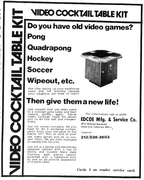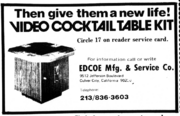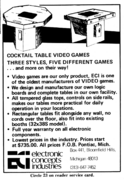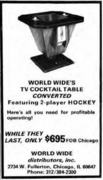Cocktail cabinet: Difference between revisions
m (→Conversions) |
mNo edit summary |
||
| Line 22: | Line 22: | ||
1975-06+07 Play Meter pg 44 03.png|(1975) | 1975-06+07 Play Meter pg 44 03.png|(1975) | ||
1975-06+07 Play Meter pg 55 04.png|(1975) | 1975-06+07 Play Meter pg 55 04.png|(1975) | ||
1975-11 Play Meter pg 53 03.png|(1975) | |||
1975-11 Play Meter pg 62 03.png|(1975) | |||
</gallery> | </gallery> | ||
[[Category:Arcade cabinets]] | [[Category:Arcade cabinets]] | ||
Revision as of 06:53, 24 January 2022
The configuration of the cocktail cabinet was a specific style of coin-operated arcade game which set video games into a vertically oriented format to be viewed from above rather than straight on. Often called cocktail tables, these cabinets may or may not allow for the resting of drinks on top of the game's protective covering. Some scholars of early video games do not consider games which do not have safe, flat areas to rest objects like drinks to be strictly cocktail cabinets.
There are two basic configurations of cocktail tables, standing and seated. A seated style of cocktail game usually implies that an average adult sitting on one side of the machine would have the ridge of the top come below their chest with the ability to reach the controls. Standing games more or less require a player to be gripping onto the table while on two legs beside it to view the action. The majority of cocktail games will have several sets of controls to allow for multiple players and will be built to accommodate two to four players around its base.
Cocktail cabinets were particularly popular in the mid 1970s before falling off in popularity. Their design also evolved into the tabletop format which swept Japan in the latter half of the 1970s.
Articles[edit]
Conversions[edit]
The cocktail conversion kit offered by Edcoe to fit many popular Pong-style games.(1975)







